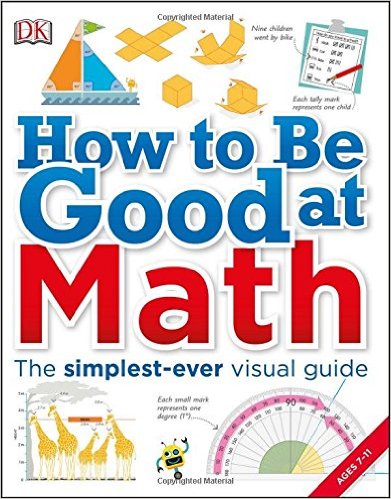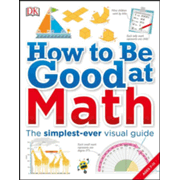How to Be Good at Math: The Simplest-ever visual guide is an unusual book. Like other DK books, it is heavily illustrated with visual representations showing how math works along with some real-world applications. The back cover says that this book “Covers all the math needed for ages 7-11 and grades 2 to 5.” This does NOT mean that you can use this to replace your math program for those grade levels. In fact, I think I would be very unlikely to use this book at all before fourth or fifth grade. Personally, I would most likely use it for review and reteaching with an older student who struggles with math or who might have some critical gaps. Coverage isn’t thorough enough for those who want to accelerate through advanced math, although it might help in a limited fashion for that purpose.
This 320-page book is divided into six sections: Numbers, Calculating, Measurement, Geometry, Statistics, and Algebra. The latter three sections cover topics at introductory levels as students might encounter up through junior high. Each section moves quickly through concepts in a normal progression but at a much more rapid pace than in a regular math program. Numerous topics under each section are each covered on either one page or a two-page spread. Frequent “Try it out” boxes present a few practice problems for students to solve. An answer key is at the back of the book.
You will generally need to choose topics from the various categories as needed rather than work straight through an entire category since the book covers topics appropriate for multiple grade levels within each category.
For example, if a child is struggling with carrying and borrowing, you might begin by reviewing place value under Numbers, then jump to the Calculating section to review addition and subtraction. If a child is struggling with fractions, you might use only the thirteen lessons on fractions in the Numbers section.
Be aware that the strategies taught in this book might be different than those a student has learned previously. While this might offer a fresh understanding of a concept for some students, it might be confusing for others.
The book was originally written for the U.K. although the book I reviewed is the American edition. Two lessons on money reflect the U.S. monetary system and were presumably rewritten for the American edition. The section on measurement primarily uses metric measurements but adds four pages on “imperial units,” the system of measurement more common in the U.S. Since our students need to learn both systems this isn’t a problem, but they might be unfamiliar with the term “imperial units.”
Depending upon their age, students might need parental assistance figuring out what sections to use in the book. Students reading at fourth-grade level and above should be able to read and understand the instructions with minimal assistance.











